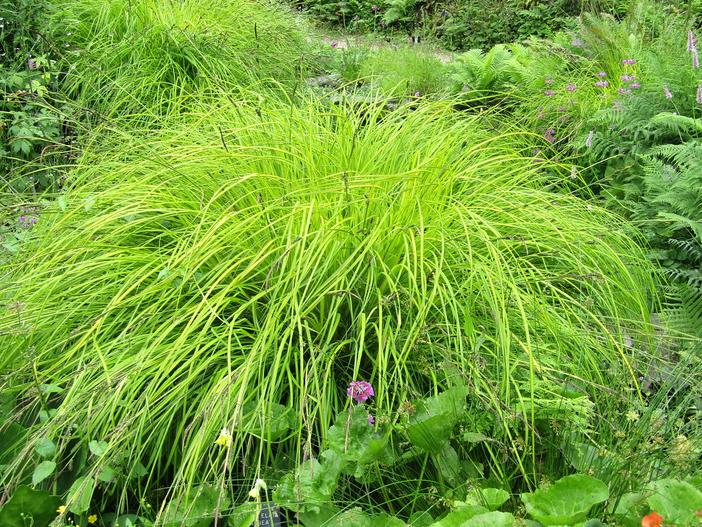Tufted Sedge
(Carex elata)
Tufted Sedge (Carex elata)
/
/

Leonora (Ellie) Enking
CC BY-SA 2.0
Image By:
Leonora (Ellie) Enking
Recorded By:
Copyright:
CC BY-SA 2.0
Copyright Notice:
Photo by: Leonora (Ellie) Enking | License Type: CC BY-SA 2.0 | License URL: https://creativecommons.org/licenses/by-sa/2.0/ | Uploader: wallygrom | Publisher: Flickr















































Estimated Native Range
Summary
Carex elata, commonly known as Tufted Sedge, is a perennial herbaceous plant native to a variety of wetland habitats including marshes, fens, riverbanks, and wet meadows across Europe, the Atlas Mountains in North Africa, Turkey, Iran, and Central Asia. It typically forms dense clumps reaching 30-90 cm in height and is characterized by its upright, grass-like leaves. The inflorescences are brownish-green, appearing in late spring to early summer, and are not particularly showy, but they add a fine texture to the plant’s overall appearance. The foliage of the ’Aurea’ cultivar is a striking yellow-green, providing a bright contrast in garden settings.
Tufted Sedge is valued for its ability to thrive in wet conditions and is often used in rain gardens, around ponds, and in other water features. It is also suitable for naturalistic plantings and as a marginal aquatic plant. ’Aurea’ is particularly noted for its golden foliage, which can brighten up damp, shady areas. Carex elata requires consistently moist to wet soil and can tolerate a range of light conditions from full sun to part shade. While generally low-maintenance, it may require division every few years to maintain vigor. It is not typically subject to serious pest or disease problems, but can become invasive if conditions are ideal.CC BY-SA 4.0
Tufted Sedge is valued for its ability to thrive in wet conditions and is often used in rain gardens, around ponds, and in other water features. It is also suitable for naturalistic plantings and as a marginal aquatic plant. ’Aurea’ is particularly noted for its golden foliage, which can brighten up damp, shady areas. Carex elata requires consistently moist to wet soil and can tolerate a range of light conditions from full sun to part shade. While generally low-maintenance, it may require division every few years to maintain vigor. It is not typically subject to serious pest or disease problems, but can become invasive if conditions are ideal.CC BY-SA 4.0
Plant Description
- Plant Type: Grass
- Height: 3-4 feet
- Width: 1-2.5 feet
- Growth Rate: Moderate
- Flower Color: N/A
- Flowering Season: Spring
- Leaf Retention: Semi-Deciduous
Growth Requirements
- Sun: Full Sun, Part Shade
- Water: High
- Drainage: Slow, Standing
Common Uses
Bird Garden, Border Plant, Deer Resistant, Erosion Control, Groundcover, Low Maintenance, Potted Plant, Street Planting, Water Garden
Natural Habitat
Wetland habitats including marshes, fens, riverbanks, and wet meadows
Other Names
Common Names: Bowles’ Golden Sedge, European Tussock Sedge, Tufted Grass, Stiv Star, Steife Segge, Piukkasara, Laîche Raide, Bunkestarr, Stijve Zegge, Bunkestorr
Scientific Names: , Carex elata, Carex cespitosa var. elata, Carex caespitosa var. elata, Carex cespitosa subsp. elata, Carex moscowensis, Carex stricta var. macra, Carex subrotunda,
GBIF Accepted Name: Carex elata All.